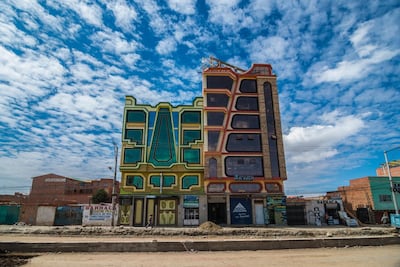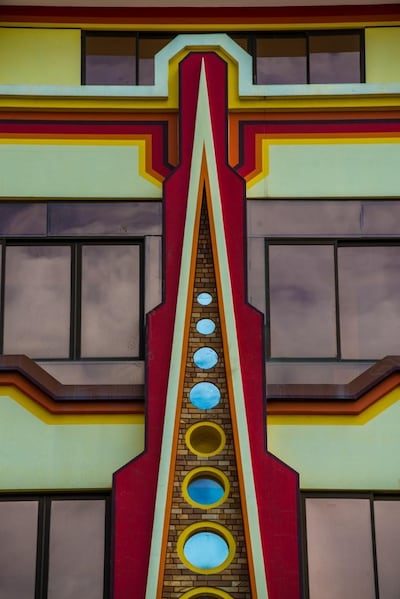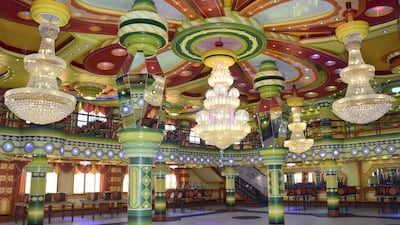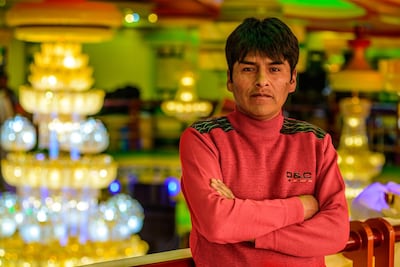At first glance, it would appear as though the buildings designed in the cholets style stand out solely for their bright colours. However, if you delve deeper into this relatively new and localised school of architecture, a more nuanced rationale begins to emerge.
Before cholets took over its streets, the city of El Alto in Bolivia wore a dusty and grim look, a stance mirrored in the monotonous, unpainted brickwork of its buildings and even by its residents. The native Andeans, or Aymara, are a people who have endured centuries of socio-political marginalisation and are pejoratively referred to as “cholos”.
And then Freddy Mamani broke onto the scene. The Bolivian bricklayer-turned-civil engineer may not have a formal degree in architecture, but he is reverentially referred to as an architect. Because, for the first time in modern Bolivia’s history, Mamani’s structures celebrate the traditional culture of the country’s indigenous people by taking on a distinct and very deliberate Aymaran identity.
Mixing heritage with architecture
A neologism coined by combining the words chalet and chola (the colourful local garbs and the women who wear them), a home designed in the cholets style is distinguishable by the sheer frenzy of its vibrant colours, swirling patterns and symbolic iconography. The zigzag recesses, circular windows and geometric reliefs are all symbolic of the pantheon of the Aymara’s ancestral Incan gods.

The trapezoidal entrances, for example, are reminiscent of the Incan temple on nearby Isla del Sol, while the stair-step shape of the chakana cross appears in the designs of the windows, doors and chairs. The spiral stairways pay homage to the wind and storms that characterise the highlands in this part of the world; the curved lines signify water, a cherished and sacred commodity; and the pitched roofs call to mind the steep peaks of the Andes.
Cultural and topographical readings aside, the symbolism is often interpreted as deeply religious. One report compared the levels of the cholets as representative of the three realms that the Aymaras believes in: Alaxpacha, the world above; Akapacha, this world we inhabit; and Manqhapacha, the world below.
Mamani’s contribution to the cityscape coincides with the emergence of an Aymara bourgeoisie, who are both the landlords and end users of his cholets. The floor plan of the technicolour towers includes a ground level, typically used as a garage, store room or retail space; the main room, used as a hall for gatherings; a series of apartments for extended family or perhaps tenants, and a rooftop penthouse for the owners.
Decor-wise, the dancehall is most representative of the cholet's exterior: wall-to-wall mirrors reflect the kaleidoscopic colours of the floor and furniture; the lights are an outlandish mix of chandeliers and tear lamps, and the double-height ceilings are detailed with flowers, circles and other motifs. Like the apartments, the hall is often rented out for events, a sustainable financial cycle that helps owners pay off the loans for their cholets. More importantly, it dedicates a hitherto unavailable place for the Aymara to come together and celebrate their fiestas.
'Architecture is the fabric of human life'
The extravagant colours – swirls of gaudy greens, fiery oranges and blinding yellows – are homage to both the colourful local garbs, and the Andean people’s love for dancing – the city celebrates about 250 festivals annually. The shades themselves are steeped with meaning: yellow and red denote energy and the Sun god; violet stands for wisdom, and blue represents the concept of infinity. The contrasting hues, too, are deliberate: the Aymara are staunch believers in the symbiosis of opposites.
“The extraordinary vibrancy of Freddy Mamani’s work is bringing a new consciousness for the intrinsic heritage of Bolivia back to his society and community in El Alto,” says architect James Law, chief executive of James Law Cybertecture.
“For me, architecture is the fabric of human life, and how architecture expresses itself is in the weave of this fabric. When it’s woven with clear, strong and symbolic icons, through the design, colours and materials, the citizens immediately live enveloped by this fabric and are reminded of the core values of their society. Sometimes, architecture is a lens through which the focus and emphasis of a culture is intensely amalgamated.”
Drawing parallels between Mamani’s cholets and the UAE’s cityscape, Law says: “I feel the desert has become the symbolic architecture of the nation. From this sand, new urban areas have arisen, yet the sand continues to play its role in the background, in the materials of the architecture and in the consciousness of the population. [Similarly], by super-charging a design with hyper infusions of symbolism, [Mamani’s] buildings become a treasure box of collected icons of a culture that is deliberately communicated in an uber-realistic way. The overall effect is an elevation of the artistic status of a city and its heritage,” he explains.
'Proud to show the world who we really are'
Of course, El Alto is not the first city and Bolivia is not the first country to use paints and pattern in such an effective manner – Rio's rainbow favelas and Cape Town's colourful Bo-Kaap are other examples. And in each case, a link exists between an updated city and more optimistic, accepting and accepted citizens.

“The colourful cholets remind us that architecture is contextual. The homes wouldn’t be more than a kitschy surprise if they were built outside the Andean region, but in their original cultural context, they become a tool for the expression of people’s identity. [In addition to] the benefit of increasing tourism, to me the biggest strength of Mamani’s work is to send a new message, something like: ‘Hey, look, we have been marginalised for centuries, but now we are proud to show the world who we really are’,” says Philippe Grasset, founder of Grasset Interior Design and Architecture.
“Mamani’s work demonstrates how deeply architecture entangles with a people’s identity. It is a physical expression of the Andean indigenous re-birthing pride. After generations of struggle against an alien culture, they finally overcome the original shock: first revealed to the world with [Aymaran President] Evo Morales’s election in 2005, Bolivian indigenous identity now reshapes the urban landscape with its renewed style,” he says.
_____________________
Read more:
The power of colour and its effect on us
Inside musician Prince's Caribbean home, complete with a purple driveway
Dubai architect Lulie Fisher to design luxury villas in Zanzibar
_____________________
Although the first cholets were completed in 2015, they continue to draw regional and international attention. The striking facades – now numbering more than 100 – have attracted so many tourists to this hitherto sleepy town, that special routes have been mapped out for keen outsiders to visit and photograph the homes. Mamani has been the subject of a book by architectural historian Elisabetta Andreoli; a documentary that explores the connection between architecture and cultural identity, and an exhibition at London’s Architectural Association School of Architecture.
Last month, a fashion show celebrating Mamani's colourful creations brought Bolivian labels such as Beatriz Canedo Patiño and Liliana Castellanos and Maman Fine Art together to design outfits and artworks to match. He was also recently invited to promote his cholets at an exhibition being held at the Cartier Foundation in Paris next month, in a effort to promote the culture of Bolivia, its festivals, food and fashion.

Of course, Mamani’s mini-renaissance is not without its detractors, who hint that the Aymaran is academically unqualified and that his garish structures are an embarrassment to the cityscape. But for the most part, the cholets are being given a shout-out – by local and international voices alike – for encapsulating the spirit of the original Bolivian and giving it newfound respect within an urban setting. And this has led to Mamani being honoured with perhaps one of the greatest monikers of his chosen industry: the architect-activist.



